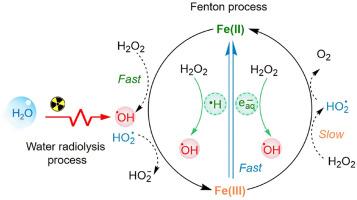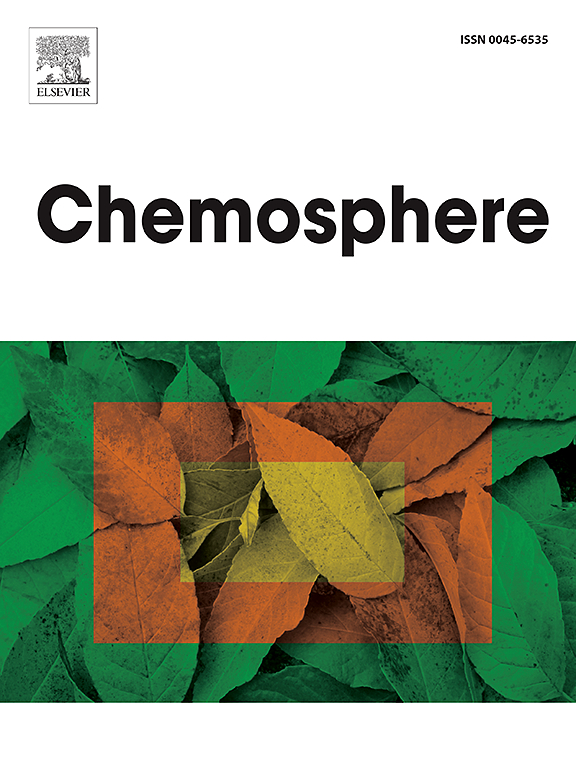调节电离辐射过程中活性物种的铁凝固剂,促进双酚 A 的降解。
IF 8.1
2区 环境科学与生态学
Q1 ENVIRONMENTAL SCIENCES
引用次数: 0
摘要
在利用电子束技术处理工业废水时,絮凝工艺经常与电子束辐射相结合,以改善水质,达到排放标准。含铁混凝剂在絮凝过程中被广泛使用。因此,本研究调查了残留含铁混凝剂对电离辐射过程中污染物降解的影响。结果表明,在 100 μM 典型铁混凝剂(FeCl3)的存在下,完全去除 50 mg/L 双酚 A 所需的吸收剂量从 5 kGy 降至 2.5 kGy。在较宽的 pH 值范围(3.0 至 10.0)内,双酚 A 的降解效率随着 FeCl3 用量的增加而提高;加入 300 uM Fe(III)后,TOC 的去除率从 20% 提高到 45%。机理研究表明,-OH 是导致双酚 A 降解的主要反应物。残留铁混凝剂(FeCl3)显著提高了降解和矿化效率。在合适的 pH 值条件下(3.0 至 6.0),还原性反应物(eaq- 和 -H)可有效地将 Fe(III) 还原成 Fe(II),然后与 H2O2 反应,从而诱导原位 Fenton 反应生成更多的 -OH,从而促进微污染物的辐射降解。本研究探索了利用絮凝过程中的残余铁混凝剂提高电子束技术处理废水性能的潜力。本文章由计算机程序翻译,如有差异,请以英文原文为准。

Iron coagulant regulating reactive species in ionizing radiation process for enhanced degradation of bisphenol A
In the treatment of industrial wastewater by electron beam technology, the flocculation process was frequently coupled with electron beam radiation to improve the water quality to meet the discharge standard. Iron-containing coagulant was widely used in the flocculation process. Therefore, this study investigated the impact of residual iron-containing coagulants on pollutant degradation by the ionizing radiation process. Results showed that the absorbed dose required for complete removal of 50 mg/L bisphenol A decreased from 5 kGy to 2.5 kGy in the presence of 100 μM typical iron coagulant (FeCl3). BPA degradation efficiency increased with the increase of FeCl3 dosage over a wide pH range (3.0–10.0), and the TOC removal efficiency increased from 20% to 45% with the addition of 300 μM Fe(III). The mechanistic investigation demonstrated that •OH was the primary reactive species responsible for BPA degradation. The residual iron coagulants (FeCl3) significantly enhanced the degradation and mineralization efficiency. Under suitable pH conditions (3.0–6.0), the reducing reactive species (eaq‒ and •H) could effectively reduce Fe(III) to Fe(II), which then reacted with H2O2, thus inducing in-situ Fenton reaction to generate more •OH, thus promoting the radiolysis degradation of micropollutants. This study explored the potential of using residual iron coagulants from the flocculation process to enhance the performance of electron beam technology for wastewater treatment.
求助全文
通过发布文献求助,成功后即可免费获取论文全文。
去求助
来源期刊

Chemosphere
环境科学-环境科学
CiteScore
15.80
自引率
8.00%
发文量
4975
审稿时长
3.4 months
期刊介绍:
Chemosphere, being an international multidisciplinary journal, is dedicated to publishing original communications and review articles on chemicals in the environment. The scope covers a wide range of topics, including the identification, quantification, behavior, fate, toxicology, treatment, and remediation of chemicals in the bio-, hydro-, litho-, and atmosphere, ensuring the broad dissemination of research in this field.
 求助内容:
求助内容: 应助结果提醒方式:
应助结果提醒方式:


